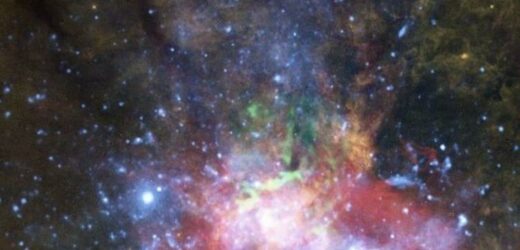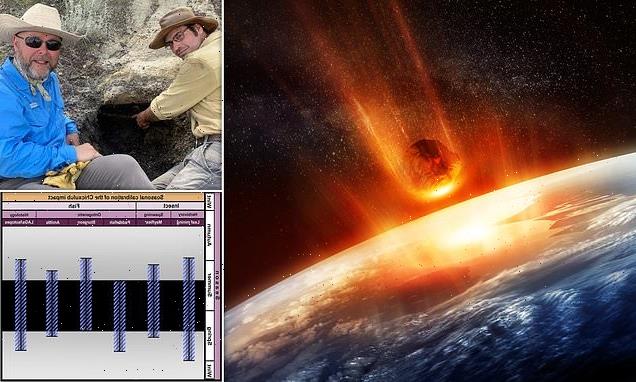Astronomers find the closest supermassive black holes to Earth
We use your sign-up to provide content in ways you’ve consented to and to improve our understanding of you. This may include adverts from us and 3rd parties based on our understanding. You can unsubscribe at any time. More info
NASA’s Hubble Telescope exposed the supermassive black hole’s blowtorch-like mini-jet that dates back several thousand years. Hubble photographed a bright knot of gas that has been impacted by an invisible jet from the black hole, which is 15 light-years from it. The image shows a composite view of X-rays, molecular gas, and warm ionized gas near the galactic centre. It has helped find circumstantial evidence that the mini-jet is still pushing into a giant hydrogen cloud and then splattering it out in what has been described as a “leak”.
The graphic of a translucent, vertical white fan has been added to the image to show the suggested axis of a mini-jet from the supermassive black hole at the galaxy’s centre.
The orange-coloured features are glowing hydrogen gas.
The top of the jet is a hydrogen cloud that has been hit by the outflowing jet.
Experts have compared their research to that of an archaeological dif as they try to peer through the interstellar pollution of dense sheets of dust and gas between Earth and the galactic centre, which is 27,000 light-years away.
The black hole is thought to have looked spectacular billions of years ago as a quasar (quasi-stellar object) when our young galaxy was feeding on large amounts of infalling gas.
After all that time the black hole still goes through fits and starts.
This discovery has also given evidence that the black hole, with a mass of 4.1 million Suns, does not sit still.


Instead, it is periodically in action as stars and gas clouds fall into it.
Black holes can draw material into a swirling, orbiting accretion disk where some of the infalling material is swept up into outflowing jets that are picked up by the black hole’s strong magnetic fields.
The thin “searchlight beams” are accompanied by a wave of ionizing radiation.
Professor Gerald Cecil, from the University of North Carolina, said: “The central black hole is dynamically variable and is currently powered down.”
Prof Cecil has made multiwavelength observations from a number of telescopes that suggest the black hole spits out mini-jets every time it takes in something big, like a gas cloud.

Co-author Alex Wagner of Tsukuba University in Japan, said: “The streams percolate out of the Milky Way’s dense gas disk.
“The jet diverges from a pencil beam into tendrils, like that of an octopus.”
This outflow results in an outflow of enlarging bubbles that extend out to at least 500 light-years.
DON’T MISS
MIT scientist claims Earth is on the brink of a mass extinction [INSIGHT]
Stonehenge breakthrough after ‘amazing discovery’ in Israel [REPORT]
Russia could deliver hammer blow to UK economy [REVEAL]


Prof Cecil said: “Like in archaeology, you dig and dig to find older and older artefacts until you come upon remnants of a grand civilization.
“Our central black hole clearly surged in luminosity at least 1 millionfold in the last million years. That sufficed for a jet to punch into the Galactic halo.”
The study was published in the Astrophysical Journal.
Source: Read Full Article


